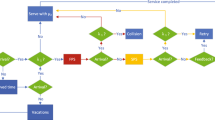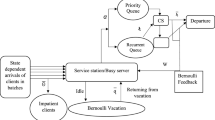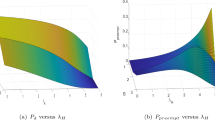Abstract
A multi-server catastrophic retrial queueing model is developed in this study, which takes into account a controllable preemptive priority scheduling with phase-type distributed retrial times. For clarity purpose, the model operating scenarios that take place before and after the tragedy are termed as the normal environment and the catastrophic environment, respectively. In a normal environment, the inbound calls are divided into handoff calls and new calls. Controllable preemptive priority is assigned to handoff calls over new calls. In the catastrophic environment, when a calamity shuts down the entire system and all the operational channels are failed, a network of backup channels is swiftly deployed to resume services. Now, the inbound calls are classified into handoff call, new call, and emergency call as a result of the emergency scenario in the affected area. Due to the immediate imperative to save lives in such circumstances, emergency calls are also given controllable preemptive priority over new or handoff calls. By establishing that the Markov chain meets the requirements for asymptotically quasi-Toeplitz Markov chains, the chain’s ergodicity critera is established. Furthermore, the non-dominated sorting genetic algorithm-II (NSGA-II) approach has been employed to tackle a multi-objective optimization problem to determine the optimal number of backup channels and threshold values of preemption.





Similar content being viewed by others
Data availability
Not applicable.
Code availability
Not applicable.
References
Dabrowski, C.: Catastrophic event phenomena in communication networks: A survey. Comput. Sci. Rev. 18, 10–45 (2015)
Chang, W.: Preemptive priority queues. Oper. Res. 13(5), 820–827 (1965)
Raj, R., Jain, V.: Optimization of traffic control in MMAP[2]/PH[2]/S priority queueing model with PH retrial times and preemptive repeat policy (2021). ar**v preprint ar**v:2107.07867
Brandwajn, A., Begin, T.: Multi-server preemptive priority queue with general arrivals and service times. Perform. Eval. 115, 150–164 (2017)
Machihara, F.: A bridge between preemptive and non-preemptive queueing models. Perform. Eval. 23(2), 93–106 (1995)
Krishnamoorthy, A., Babu, S., Narayanan, V.C.: MAP/(PH/PH)/c queue with self-generation of priorities and non-preemptive service. Stoch. Anal. Appl. 26(6), 1250–1266 (2008)
Kim, J., Kim, B.: A survey of retrial queueing systems. Ann. Oper. Res. 247(1), 3–36 (2016)
Sudhesh, R., Mohammed Shapique, A., Dharmaraja, S., et al.: Analysis of a multiple dual-stage vacation queueing system with disaster and repairable server. Methodol. Comput. Appl. Prob. 24(4), 2485–2508 (2022)
Sudhesh, R., Savitha, P., Dharmaraja, S.: Transient analysis of a two-heterogeneous servers queue with system disaster, server repair and customers’ impatience. Top 25(1), 179–205 (2017)
Baumann, H., Sandmann, W.: Steady state analysis of level dependent quasi-birth-and-death processes with catastrophes. Comput. Oper. Res. 39(2), 413–423 (2012)
Yajima, M., Phung-Duc, T.: A central limit theorem for a Markov-modulated infinite-server queue with batch Poisson arrivals and binomial catastrophes. Perform. Eval. 129, 2–14 (2019)
Yechiali, U.: Queues with system disasters and impatient customers when system is down. Queueing Syst. 56(3), 195–202 (2007)
Zhou, J., Beard, C.C.: A controlled preemption scheme for emergency applications in cellular networks. IEEE Trans. Veh. Technol. 58(7), 3753–3764 (2009)
Chakravarthy, S.R.: A catastrophic queueing model with delayed action. Appl. Math. Model. 46, 631–649 (2017)
Kumar, N., Gupta, U.: Analysis of batch Bernoulli process subject to discrete-time renewal generated binomial catastrophes. Ann. Oper. Res. 287(1), 257–283 (2020)
Wang, J., Liu, B., Li, J.: Transient analysis of an M/G/1 retrial queue subject to disasters and server failures. Eur. J. Oper. Res. 189(3), 1118–1132 (2008)
Chakravarthy, S.R., Dudin, A.N., Klimenok, V.I.: A retrial queueing model with map arrivals, catastrophic failures with repairs, and customer impatience. Asia Pac. J. Oper. Res. 27(06), 727–752 (2010)
Ammar, S.I., Rajadurai, P.: Performance analysis of preemptive priority retrial queueing system with disaster under working breakdown services. Symmetry 11(3), 419 (2019)
Chakravarthy, S.R.: A retrial queueing model with thresholds and phase type retrial times. J. Appl. Math. Inform. 113(3–4), 351 (2020)
Jain, V., Raj, R., Dharmaraja, S.: Numerical optimization of loss system with retrial phenomenon in cellular networks. Int. J. Oper. Res. 46, 210–226 (2021)
Dharmaraja, S., **dal, V., Alfa, A.S.: Phase-type models for cellular networks supporting voice, video and data traffic. Math. Comput. Model. 47(11–12), 1167–1180 (2008)
Shin, Y.W., Moon, D.H.: Approximation of M/M/c retrial queue with PH-retrial times. Eur. J. Oper. Res. 213(1), 205–209 (2011)
Elmeseiry, N., Alshaer, N., Ismail, T.: A detailed survey and future directions of unmanned aerial vehicles (UAVs) with potential applications. Aerospace 8(12), 363 (2021)
Alsamhi, S., Rajput, N.: Implementation of call admission control technique in hap for enhanced QoS in wireless network deployment. Telecommun. Syst. 63, 141–151 (2016)
Latouche, G., Ramaswami, V.: Introduction to Matrix Analytic Methods in Stochastic Modeling. SIAM, Philadelphia (1999)
He, Q.-M.: Fundamentals of Matrix-Analytic Methods. Springer, New York (2014)
Deb, K., Pratap, A., Agarwal, S., Meyarivan, T.: A fast and elitist multiobjective genetic algorithm: NSGA-II. IEEE Trans. Evol. Comput. 6(2), 182–197 (2002)
Klimenok, V., Dudin, A.: Multi-dimensional asymptotically quasi-Toeplitz Markov chains and their application in queueing theory. Queueing Syst. 54(4), 245–259 (2006)
Dayar, T.: Analyzing Markov Chains Using Kronecker Products: Theory and Applications. Springer, New York (2012)
Artalejo, J.R., Gomez-Corral, A.: Modelling communication systems with phase type service and retrial times. IEEE Commun. Lett. 11(12), 955–957 (2007)
Funding
The first author, Raina Raj is supported by a senior research fellowship (SRF) Grant No.- 09/1131(0024)/2018-EMR-I from Council of Scientific and Industrial Research (CSIR), India.
Author information
Authors and Affiliations
Contributions
All the authors have equally contributed to the work. RR and VJ formulated the model. RR completed the mathematical analysis. VJ verified the results and modified the manuscript. RR and VJ reviewd the manuscript.
Corresponding author
Ethics declarations
Conflict of interest
The authors declare that they have no competing interests.
Additional information
Publisher's Note
Springer Nature remains neutral with regard to jurisdictional claims in published maps and institutional affiliations.
Rights and permissions
Springer Nature or its licensor (e.g. a society or other partner) holds exclusive rights to this article under a publishing agreement with the author(s) or other rightsholder(s); author self-archiving of the accepted manuscript version of this article is solely governed by the terms of such publishing agreement and applicable law.
About this article
Cite this article
Raj, R., Jain, V. Resource optimization for MMAP[c]/PH[c]/S catastrophic queueing model with PH retrial times. OPSEARCH (2024). https://doi.org/10.1007/s12597-023-00731-3
Accepted:
Published:
DOI: https://doi.org/10.1007/s12597-023-00731-3




